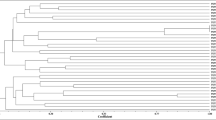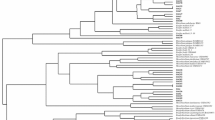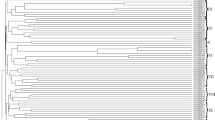Abstract
Genista saharae is an indigenous shrub legume that spontaneously grows in the northeastern Algerian Sahara. It is known for efficient dune fixation and soil preservation against desertification, due to its drought tolerance and its contribution to sustainable nitrogen resources implemented by biological N2-fixation. In this study, the root nodule bacteria of G. saharae were investigated using phenotypic and phylogenetic characterization. A total of 57 rhizobial strains were isolated from nodules from several sites in the hyper-arid region of Metlili and Taibet (east Septentrional Sahara). They all nodulate G. saharae species but they differed in their symbiotic efficiency and effectiveness. The genetic diversity was assessed by sequencing three housekeeping genes (atpD, recA and 16S rRNA). The majority of isolates (81 %) belonged to the genus Ensifer (previously Sinorhizobium), represented mainly by the species Ensifer meliloti. The next most abundant genera were Neorhizobium (17 %) with 3 different species: N. alkalisoli, N. galegae and N. huautlense and Mesorhizobium (1.75 %) represented by the species M. camelthorni. Most of the isolated strains tolerated up to 4 % (w/v) NaCl and grew at 45 °C. This study is the first report on the characterization of G. saharae microsymbionts in the Algerian Sahara.


Similar content being viewed by others
References
Amrani S, Noureddine NE, Bhatnagar T, Argandoña M, Nieto JJ, Vargas C (2010) Phenotypic and genotypic characterization of rhizobia associated with Acacia saligna (Labill.) Wendl. in nurseries from Algeria. Syst Appl Microbiol 33:44–51. doi:10.1016/j.syapm.2009.09.003
Berrada H, Nouioui I, Iraqui Houssaini M, El Ghachtouli N, Gtari M, Fikri Benbrahim K (2012) Phenotypic and genotypic characterizations of rhizobia isolated from root nodules of multiple legume species native of Fez, Morocco. Afr J Microbiol Res 6:5314–5324. doi:10.5897/AJMR11.1505
Bertrand H, Plassard C, Pinochet X, Touraine B, Normand P, Cleyet-Marel JC (2000) Stimulation of the ionic transport system in Brassica napus by a plant growth-promoting rhizobacterium (Achromobacter sp.). Can J Microbiol 46:229–236. doi:10.1139/cjm-46-3-229
Brockwell J, Searle SD, Jeavons AC, Waayers M (2005) Nitrogen fixation in Acacias: an untapped resource for sustainable plantations, farm forestry and land reclamation. Australian Centre for International Agricultural Research, Canberra
Chehma A, Faye B, Bastianelli D (2010) Valeurs nutritionnelles des plantes vivaces des Parcours sahariens algériens pour dromadaires. Fourrages 204:263–268
Chen WP, Kuo TT (1993) A simple and rapid method for the preparation of gram-negative bacterial genomic DNA. Nucleic Acids Res 21:2260. doi:10.1093/nar/21.9.2260
Chen WM, Zhu WF, Bontemps C, Young JPW, Wei GH (2011) Mesorhizobium camelthorni sp. nov., isolated from Alhagi sparsifolia. Int J Syst Evol Microbiol 61:574–579. doi:10.1099/ijs.0.022947-0
Cox MM (2003) The bacterial RecA protein as a motor protein. Annu Rev Microbiol 57:551–577. doi:10.1146/annurev.micro.57.030502.09095
Fernando GA, Jesus M (1998) Biodiversity of rhizobia nodulating Genista monspessulana and Genista linifolia in Spain. N Z J Agric Res 41:585–594. doi:10.1080/00288233.1998.9513342
Gaunt MW, Turner SL, Rigottier-Gois L, Lloyd-Macgilps SA, Young JP (2001) Phylogenies of atpD and recA support the small subunit rRNA-based classification of rhizobia. Int J Syst Evol Microbiol 51:2037–2048. doi:10.1099/00207713-51-6-2037
Ghosh W, Roy P (2006) Mesorhizobium thiogangeticum sp. nov., a novel sulfur-oxidizing chemolithoautotroph from rhizosphere soil of an Indian tropical leguminous plant. Int J Syst Evol Microbiol 56:91–97. doi:10.1099/ijs.0.63967-0
Kalita M, Malek W (2004) Phenotypic and genomic characteristics of Rhizobia isolated from Genista tinctoria root nodules. Syst Appl Microbiol 27:707–715
Karanja NK, Wood M (1988) Selecting Rhizobium phaseoli strains for use with beans (Phaseolus vulgaris L.) in Kenya: infectiveness and tolerance of acidity and aluminium. Plant Soil 112:7–13. doi:10.1007/BF02181746
Le Houérou HN (1990) Définition et limites bioclimatiques du Sahara. Sécheresse 1:246–259
Le Houérou HN (1997) Biodiversité végétale et diversité génétique en Afrique. Sécheresse 2:117–122
Lloyd AT, Sharp PM (1993) Evolution of the recA gene and the molecular phylogeny of bacteria. J Mol Evol 37:399–407. doi:10.1007/BF00178869
Mahdhi M, Nzoué A, Gueye F, Merabet C, de Lajudie P, Mars M (2007) Phenotypic and genotypic diversity of Genista saharae microsymbionts from the infra-arid region of Tunisia. Lett Appl Microbiol 45:604–609. doi:10.1111/j.1472-765X.2007.02233.x
Martens M, Delaere M, Coopman R, De Vos P, Gillis G, Willems A (2007) Multilocus sequence analysis of Ensifer and related taxa. Int J Syst Evol Microbiol 57:489–503. doi:10.1099/ijs.0.64344-0
Martens M, Dawyndt P, Coopman R, Gillis M, De Vos P, Willems A (2008) Advantages of multilocus sequence analysis for taxonomic studies: a case study using 10 housekeeping genes in the genus Ensifer (including former Sinorhizobium). Int J Syst Evol Microbiol 58:200–214. doi:10.1099/ijs.0.65392-0
Maynaud G, Willems A, Soussou S, Vidal C, Mauré L, Moulin L et al (2012) Molecular and phenotypic characterization of strains nodulating Anthyllis vulneraria in mine tailings, and proposal of Aminobacter anthyllidis sp. nov., the first definition of Aminobacter as legume-nodulating bacteria. Syst Appl Microbiol 35:65–72. doi:10.1016/j.syapm.2011.11.002
Merabet C, Martens M, Mahdhi M, Zakhia F, Sy A, Le Roux C et al (2010) Multilocus Sequence analysis of root nodule isolates from Lotus arabicus (Senegal), Lotus creticus, Argyrolobium uniflorum and Medicago sativa (Tunisia) and description of Ensifer numidicus sp. nov. and Ensifer garamanticus sp. nov. Int J Syst Evol Microbiol 60:664–674. doi:10.1099/ijs.0.012088-0
Meriane D, Kaabache M (2012) Ecology, biology and biometry of an endemic fabaceae: genista saharae cosson and durieu. J Life Sci 6:501
Mnasri B, Mrabet M, Laguerre G, Aouani ME, Mhamdi R (2007) Salt-tolerant rhizobia isolated from a Tunisian oasis that are highly effective for symbiotic N2-fixation with Phaseolus vulgaris constitute a novel biovar (bv. mediterranense) of Sinorhizobium meliloti. Arch Microbiol 187:79–85. doi:10.1007/s00203-006-0173-x
Mousavi SA, Österman J, Wahlberg N, Nesme X, Lavire C et al (2014) Phylogeny of the Rhizobium–Allorhizobium–Agrobacterium clade supports the delineation of Neorhizobium gen. nov. Syst Appl Microbiol 37:208–15. doi:10.1016/j.syapm.2013.12.007
Nedjraoui D (2001) Country Pasture/Forage Resource Profiles: Algeria
Nicholas KB, Nicholas HB (1997) GeneDoc: a tool for editing and annotating multiple sequence alignments. Pittsburgh Supercomputing Center, Pittsburgh
OZENDA P (1991) Flore du Sahara, 3ème édition complétée, Paris, Centre national de la recherche scientifique (CNRS)
Quezel P (1978) Analyses of the flora Mediterranean and Saharan Africa. Ann Mo Bot Gard 56:479–534
Rejili M, Mahdhi M, Fterich A, Dhaoui S, Guefrachi I, Abdeddayem R et al (2012) Symbiotic nitrogen fixation of wild legumes in Tunisia: soil fertility dynamics, field nodulation and nodules effectiveness. Agric Ecosyst Environ 157:60–69. doi:10.1016/j.agee.2012.01.015
Rivas R, García-Fraile P, Velázquez E (2009) Taxonomy of bacteria nodulating legumes. Microbiol Insights 2:51–69
Schloss PD, Westcott SL, Ryabin T, Hall JR, Hartmann M, Hollister EB et al (2009) Introducing mothur: open-source, platform-independent, community-supported software for describing and comparing microbial communities. Appl Environ Microbiol 75:7537–7541. doi:10.1128/AEM.01541-09
Sharma SR, Rao NK, Gokhale TS, Ismail S (2013) Isolation and characterization of salt-tolerant rhizobia native to the desert soils of United Arab Emirates. Emir J Food Agric 25:102–108. doi:10.9755/ejfa.v25i2.7590
Szeto WW, Zimmerman JL, Ausubel SV, FMA (1984) Rhizobium meliloti symbiotic regulatory gene. Cell 36:1035–43. doi:10.1078/0723202042369965
Tamura K, Peterson D, Peterson N, Stecher G, Nei M, Kumar S (2011) MEGA5: molecular evolutionary genetics analysis using maximum likelihood, evolutionary distance, and maximum parsimony methods. Mol Biol Evol 28:2731–27339. doi:10.1093/molbev/msr121
Thompson JD, Gibson TJ, Plewniak F, Jeanmougin F, Higgins DG (1997) The CLUSTAL_X windows interface: flexible strategies for multiple sequence alignment aided by quality analysis tools. Nucleic Acids Res 25:4876–4882. doi:10.1093/nar/25.24.4876
Udvardi M, Poole PS (2013) Transport and metabolism in legume-rhizobia symbioses. Annu Rev Plant Biol 64:781–785. doi:10.1146/annurev-arplant-050312-120235
Vincent JM (1970) A manual for practical study of root nodule bacteria. IBP Handbook 15. Blackwell Sci. Publ. Oxford
Wawrik B, Kerkhof L, Zylstra GJ, Kukor JJ (2005) Identification of unique type II polyketide synthase genes in soil. Appl Environ Microbiol 71:2232–2238. doi:10.1128/AEM.71.5.2232-2238.2005
Zahran HH (1999) Rhizobium-legume symbiosis and nitrogen fixation under severe conditions and in an arid climate. Microbiol Mol Biol Rev 63:968–89
Zakhia F, Jeder H, Domergue O, Willems A, Cleyet-Marel JC, Gillis M et al (2004) Characterisation of wild legume nodulating bacteria (LNB) in the infra-arid zone of Tunisia. Syst Appl Microbiol 27:380–395. doi:10.1078/0723-2020-00273
Acknowledgments
We would like to gratefully acknowledge Prof. Ahmed Boutarfaya and Prof. Samia Bissati, (both from the University of Kasdi Merbah-Ouargla) for their support and encouragement.
Author information
Authors and Affiliations
Corresponding author
Ethics declarations
Funding statement
This work was supported by the Ministère de l’Enseignement Supérieur et de la Recherche Scientifique (MESRS) of Algeria. The funder had no role in study design, data collection and analyses, preparation of the manuscript or decision to publish.
Conflict of interest
The authors declare that there are no personal, financial or any other conflicts of interest to declare.
Ethical statement
This article does not contain any studies with human participants and/or animals performed by any of the authors. The formal consent is not required in this study.
Rights and permissions
About this article
Cite this article
Chaïch, K., Bekki, A., Bouras, N. et al. Rhizobial diversity associated with the spontaneous legume Genista saharae in the northeastern Algerian Sahara. Symbiosis 71, 111–120 (2017). https://doi.org/10.1007/s13199-016-0414-y
Received:
Accepted:
Published:
Issue Date:
DOI: https://doi.org/10.1007/s13199-016-0414-y




